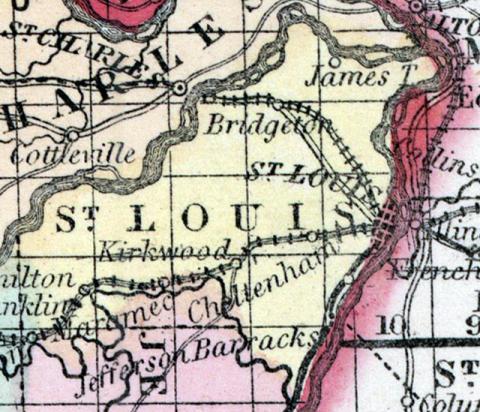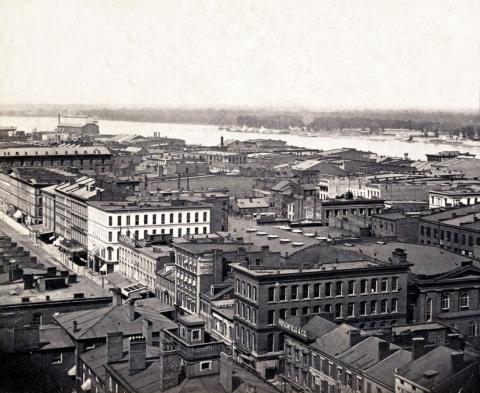ST. LOUIS, MO. City, and seat of justice of St. Louis co. On the W. bank of the Mississippi River, 18 miles below the mouth of the Missouri. 130 miles E. from Jefferson City, the capital of the state, and 1101 miles, by the course of the river, N. from New Orleans. Population in 1810, 1600; in 1820, 4598; in 1830, 6694; in 1840, 16,469; in 1850, 82,774. St. Louis is the commercial metropolis of Missouri, and was formerly the seat of government. (Gazetteer of the United States of America, 1854)
ST. LOUIS, a city, port of entry, and seat of justice of St. Louis county. Missouri, is situated on the right bank of the Mississippi river, 20 miles below the entrance of the Missouri, 174 above the mouth of the Ohio, 744 below the Falls of St. Anthony, 1194 above New Orleans, and 128 miles E. from Jefferson City. Lat. 38° 37' 28" N., Ion. 90° 15' 16" W. The site rises from the river by two plateaux of limestone formation, the first 20 and the other 60 feet above the floods of the Mississippi. The ascent to the first plateau, or bottom as it maybe termed, is somewhat abrupt; the second rises more gradually, and spreads out into an extensive plain, affording fine views of the city and river. St. Louis extends in all nearly 7 miles by the curve of the Mississippi, and about 3 miles back; the thickly settled portion, however, is only 2 or 2-1/2 miles in length, following the river, and about 1-1/4 miles in breadth. The city is well laid out, the streets being for the most part 60 feet wide, and, with but few exceptions, intersect each other at right angles. Front Street, extending along the levee, is upwards of 100 feet wide, and built up on the side facing the river with a range of massive stone warehouses, which make an imposing appearance as the city is approached by water. Front, Main, and Second streets, parallel to each other and to the river, are the seat of the principal wholesale business. The latter is occupied with heavy grocery, iron, receiving and shipping houses. Fourth street, the fashionable promenade, contains the finest retail stores. The streets parallel to Front and Main streets are designated Second street, Third, Fourth, Fifth, and so on; and those on the right and left of Market street, extending at right angles with the river, are mostly named from various forest trees, similar to the streets of Philadelphia. Large expenditures have been made from time to time in grading and otherwise improving the streets and alleys of St. Louis; and it is stated that at the present time a greater amount of work of this kind is under contract than has ever been undertaken by the city in any former year. As yet, but slight provision has been made for public squares, but immediate attention to this subject is earnestly recommended by the mayor in his late message of October, 1868. One handsome enclosure, called Lafayette Square, is now being laid out in the southern section of the city, about 2 miles S. W. from the court house. St. Louis is handsomely built, especially the new portion of the city; the principal material is brick, though limestone is employed to some extent.
It may be doubted whether any city of the Union has improved more rapidly than this in the style of its public buildings. But twenty-four years ago a court house was erected at a cost of $14,000; it was then considered a handsome edifice, and sufficient for all future purposes. Within a few years, however, this building has given place to a new structure, now nearly completed, the cost of which will scarcely fall short of half a million of dollars. It is constructed of Genevieve limestone, and occupies an entire square bounded by Market, Chestnut, Fourth, and Fifth streets. The style of architecture somewhat resembles that of the capitol at Washington. The fronts are adorned with porticos, and in the interior is a rotunda, lighted from the dome. The "Market and Town House," erected at a cost of $20,000,has been pulled down, and the "Centre Market Buildings," a handsome block, now occupies their place. The old City Hall, at, the foot of Market street, is still standing. Its speedy demolition, however, is regarded by the citizens as already decreed, and at the present time even, negotiations are pending for the purchase of a site at the corner of Thirteenth and Olive streets, upon which to erect a new edifice, of a size and style corresponding to the present prospects of the city. Of the four churches —the Catholic, the Presbyterian, the Episcopal, and the Baptist— which were all the town contained in 1829, not a vestige now remains; but in their stead had arisen in 1850, 49 others, viz. 12 Catholic, 12 Methodist, 8 Presbyterian, 5 Episcopal, 2 Unitarian, 2 Evangelical, and 1 Boatmen's, besides 2 Jewish synagogues. At the present time the number of churches in St. Louis is probably not less than 60, several of which have cost above a hundred thousand dollars. Of these, St. George's, (Episcopal,) at the corner of Locust and Seventh streets, the Catholic cathedral, on Walnut street, between Second and Third, and the Church of the Messiah, a magnificent Gothic edifice recently erected by the Unitarians, at the corner of Olive and Ninth streets, are regarded as the finest. The Cathedral is 136 feet long and 84 feet wide, with a front of polished freestone 58 feet high, adorned with a Doric portico. In the tower is a chime of bells, the heaviest of which weighs 2000 pounds. The United States arsenal, situated on Arsenal street, in the extreme south-eastern section of the city, is a large and imposing edifice enclosed by handsomely ornamented grounds. Jefferson barracks are located about 13 miles below, on the bank of the Mississippi.
The principal hotels in St. Louis, are the Planters' House, on Fourth street, between Pine and Chesnut; the United States Hotel, at the corner of Market and Third streets; the Virginia Hotel, corner of Main and Green streets; the Missouri Hotel, corner of Main and Morgan streets, and the Monroe House, at the corner of Second and Olive streets. The Planters' House is one of the largest and finest hotels in the West, and occupies the entire front between Pine and Chestnut streets. Another first-class hotel is also being erected......
The population of St. Louis in 1830 was 6694, showing an increase of only 2096 in ten years. In 1840 it had much more than doubled, having reached 16,469. Between these periods, therefore, we are to look for the commencement of that vast increase which has so distinguished the growth of this city. Population in 1850, 75,204 free, and 2650 slaves: total, 77,850. Of these, 23,774 were born in Germany; 11,257 in Ireland; 2933 in England, and 2450 in other foreign countries—making an aggregate of 40,414 natives of foreign countries, and 37,436 natives of the United States. By a local census of 1862, St. Louis contained a population of 94,819, and if to this we add the population of the suburbs, it would swell the number to upwards of 100,000 souls, being an increase of about 20,000 since 1850, and of nearly 84,000 since 1840. (Baldwin's New and Complete Gazetteer of the United States..., 1854)


